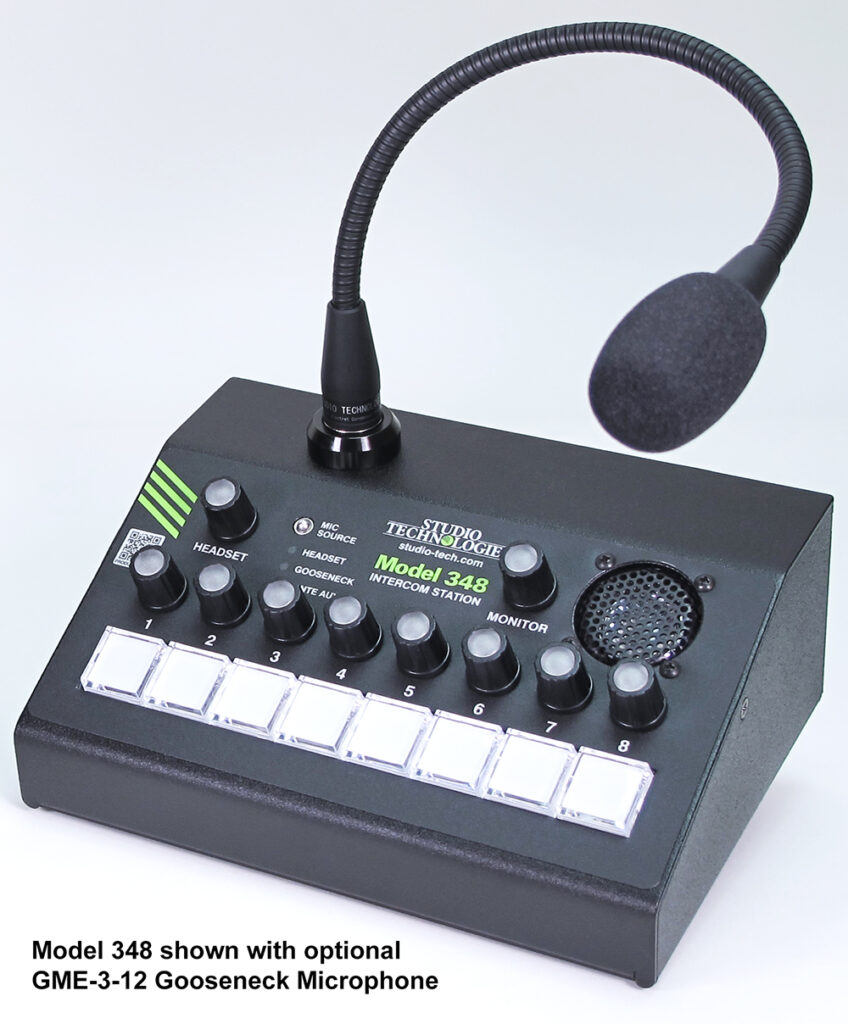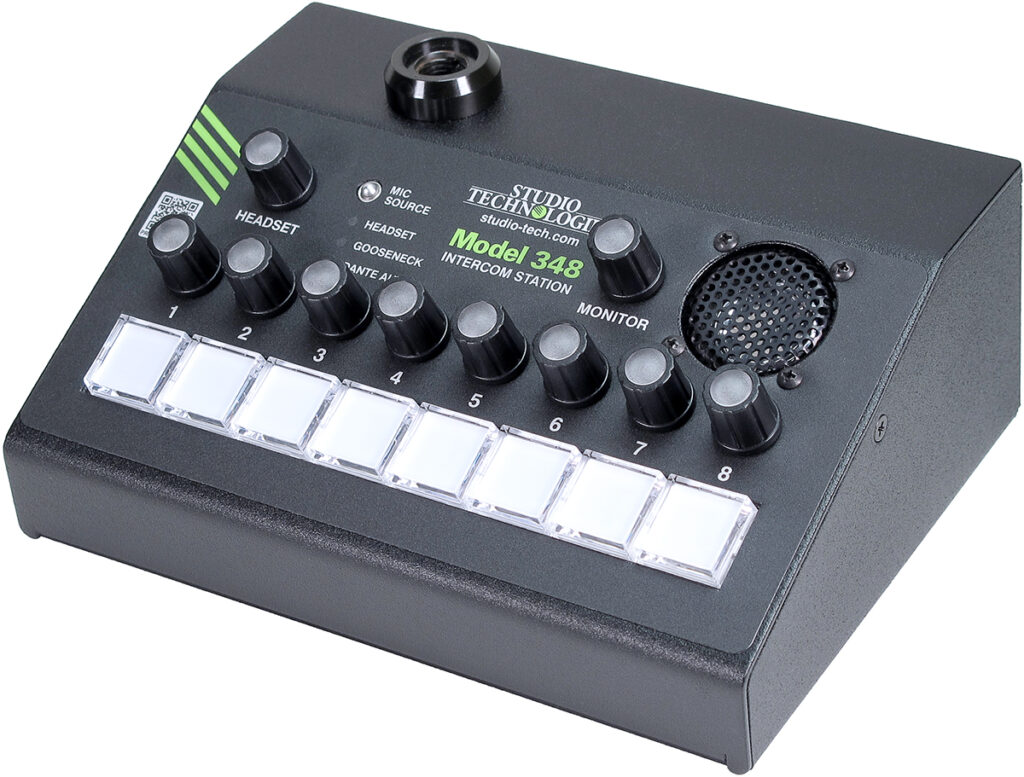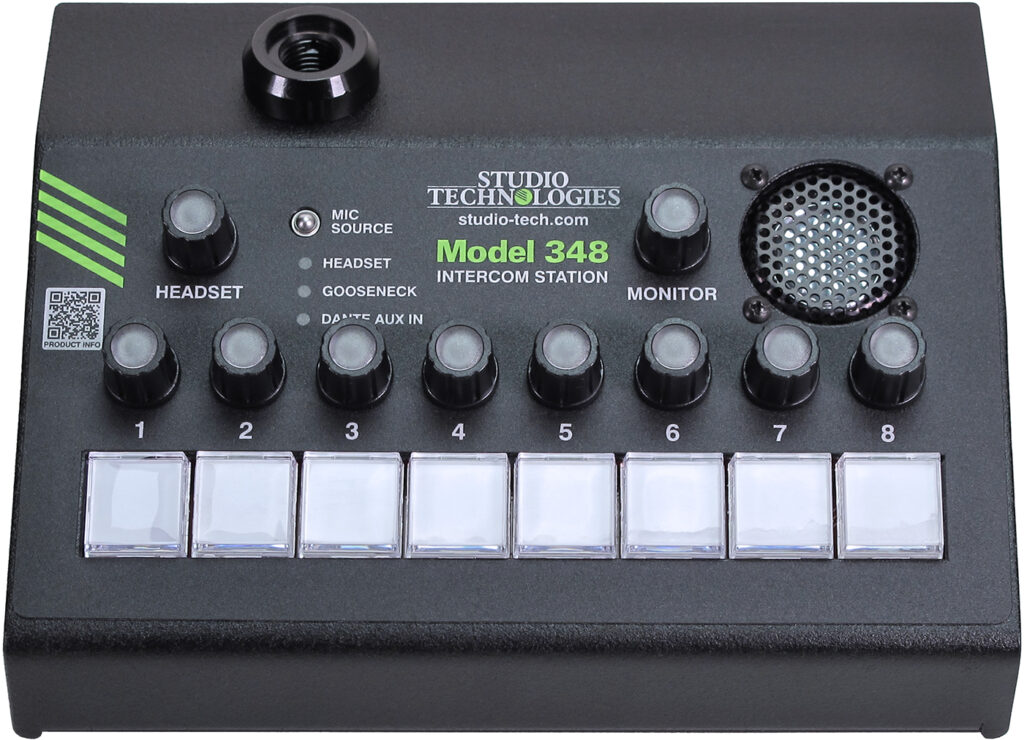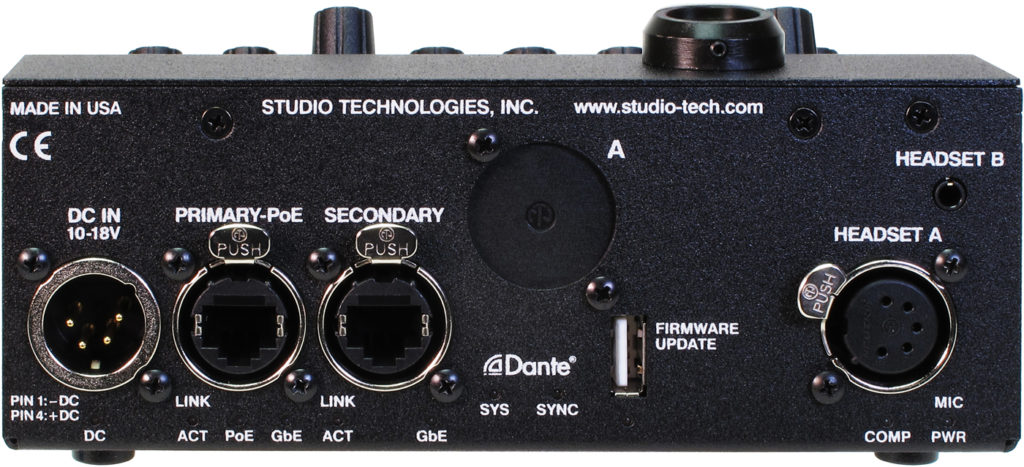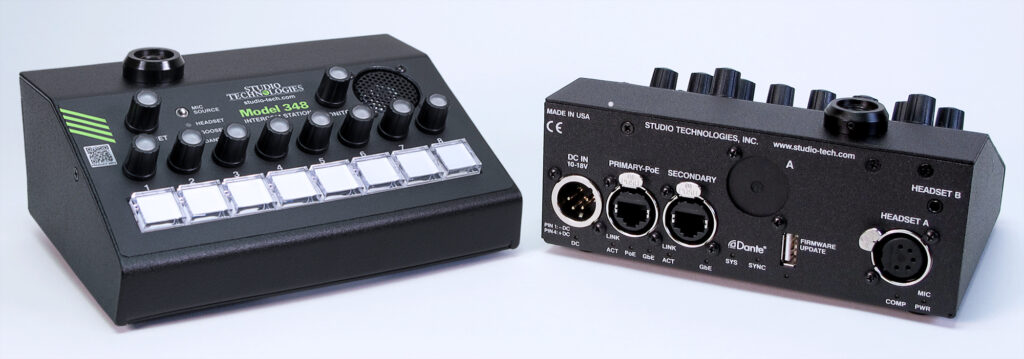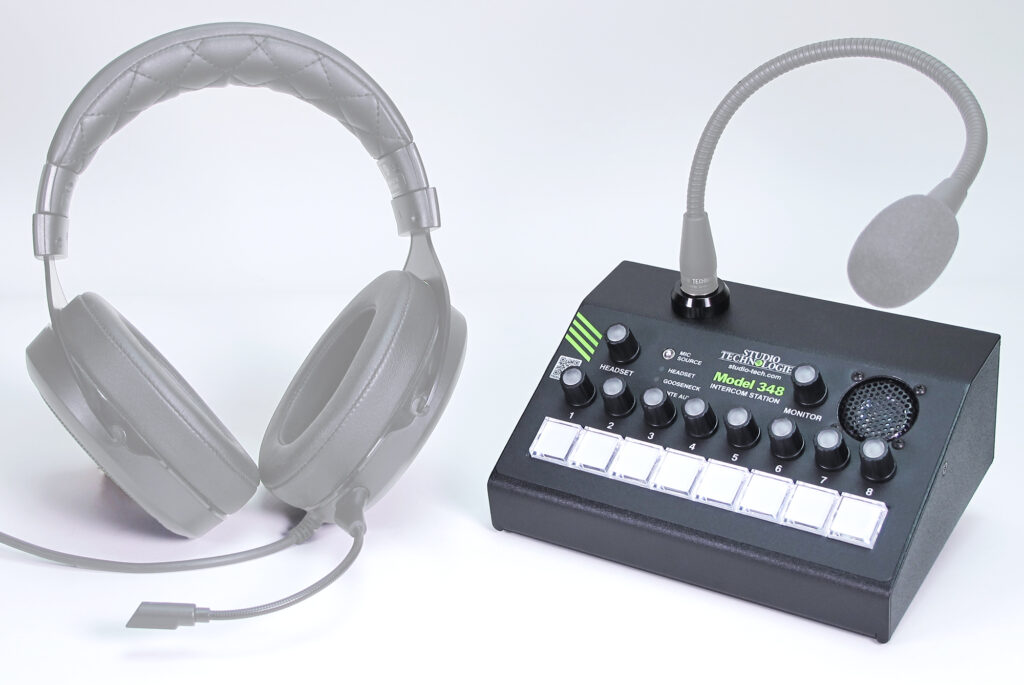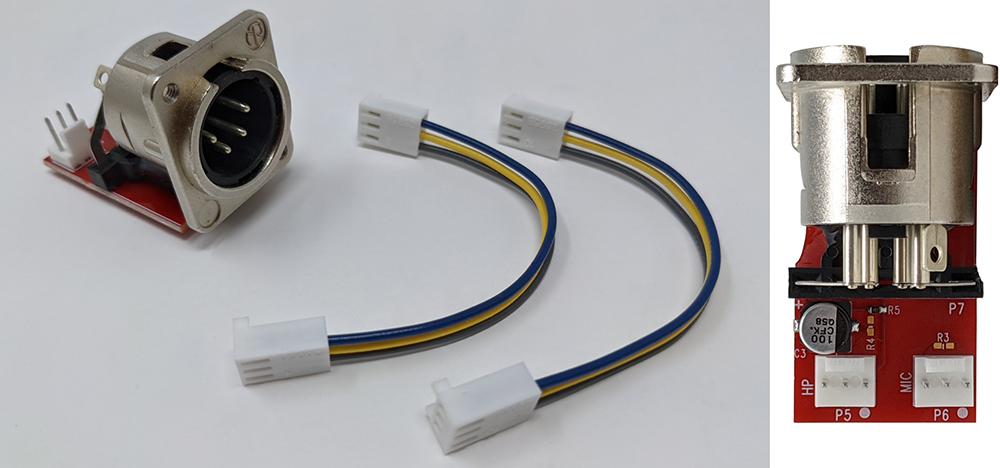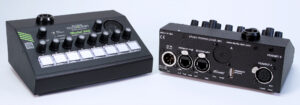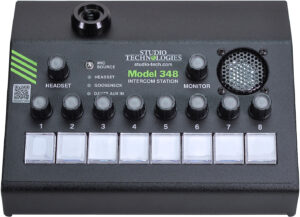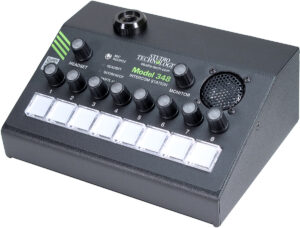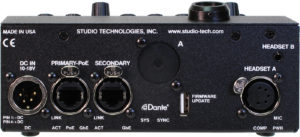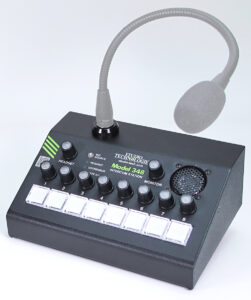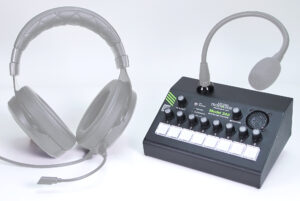Applications: Dante-based intercom, broadcast IFB (talent cue) master station, audio monitor mixer, aerospace (including capsule communicator (CapCom)), and specialized tone generation
Power Sources:
Power-over-Ethernet (PoE): class 3 mid-power, ≤12.94 watts) per IEEE® 802.3af
DC Input: 10 to 18 volts DC, 1.1 A maximum at 12 volts DC (can be powered by optional PS-DC-02)
Network Audio Technology:
Type: Dante audio-over-Ethernet
AES67-2018 Support: yes, selectable on/off
Dante Domain Manager (DDM) Support: yes
Ethernet Interface Configuration: Switched or Redundant
Bit Depth: 16, 24, or 32
Sample Rate: 48 kHz
Dante Receiver (Input) Channels: 16
Dante Transmitter (Output) Channels: 12
Dante Audio Flows: 32; 16 transmitter, 16 receiver
Internal Digital Audio Processing: 32-bit, fixed
Input-to-Output Audio Processing Latency: <200 uSec
Nominal Input and Output Level: –20 dBFS
Network Interfaces: 2, Primary-PoE and Secondary
Type: 1000BASE-T Gigabit Ethernet (GigE) per IEEE 802.3ab (10 and 100 Mb/s not supported)
Power-over-Ethernet (PoE): per IEEE 802.3af (applicable to Primary-PoE network interface only)
Microphone Input – Headset:
Compatibility – Headset A: single- or dual-ear broadcast-style with dynamic or electret (low-voltage DC-powered) microphone: pin 1 mic common; pin 2 mic; pin 3 phones common; pin 4 phones left; pin 5 phones right
Compatibility – Headset B: CTIA™/AHJ configuration (typically uses electret powered mic): tip phones left; ring 1 phones right; ring 2 common; sleeve mic
Type: unbalanced
Microphone Power: 3.3 volts DC via 2.00 k resistor, selectable on/off
Impedance: 1 k ohms, nominal, microphone power off; 690 ohms, nominal, microphone power on
Gain: 26, 32, 38, 44, 50 dB, selectable
Frequency Response: –4 dB at 30 Hz, –2.6 dB at 40 Hz, –1.8 dB at 50 Hz, –2.4 dB at 10 kHz, –3.8 dB at 20 kHz
Distortion (THD+N): <0.09%, measured at –20 dBFS, 22 Hz to 22 kHz bandwidth, 38 dB of gain
Dynamic Range: >93 dB, A-weighted, 26 dB gain
Microphone Input – Gooseneck:
Compatibility: Studio Technologies’ GME-3-12
Microphone Power: 3.3 volts DC via 2.49 k resistor
Impedance: 3.3 k ohms, nominal
Gain: 12, 18, 24, 30, 36, 42 dB, selectable
Frequency Response: –3.0 dB at 40 Hz, –2.0 dB at 50 Hz, –2.0 dB at 16 kHz, –3.0 dB at 20 kHz
Distortion (THD+N): <0.04%, measured at –20 dBFS, 22 Hz to 22 kHz bandwidth, 36 dB of gain
Dynamic Range: >97 dB, A-weighted, 12 dB gain
Compressor:
Application: applies to headset and gooseneck microphone audio
Threshold: 1 dB above nominal Dante transmitter (output) level (–19 dBFS) (–13 dBFS when gooseneck mic gain selected for 42 dB)
Slope: 2:1
Status LED: compressor active
Dante Receivers (Inputs) – Monitor 1-8:
Frequency Response: not applicable, sources are Dante receivers which pass data through to Dante transmitters
Dante Receivers (Inputs) – IFB Program 1-7, Aux In:
Frequency Response (Call Detect Disabled): Not applicable, sources are Dante receivers which pass data through to Dante transmitters
Frequency Response (Call Detect Enabled): 20 Hz to 12 kHz, +0/ –3 dB, nominal
Level Trim (Aux In): –12, –6, 0, 6, and 12 dB, adjustable
Dante Transmitters (Outputs) – Monitor Outputs 1-2:
Dim (Attenuation): 0, 6, 12, 18 dB, configurable
Dante Transmitter (Output) – Tally Tone:
Frequency: 18 kHz sine wave
Level: –20 dBFS
Headset Headphone Output:
Type: 2-channel (stereo)
Compatibility: intended for connection to stereo (dual-channel) or monaural (single-channel) headsets with a nominal impedance of 50 ohms or greater
Maximum Output Voltage: 3.0 Vrms, 1 kHz, 150 ohm load
Frequency Response: 20 Hz to 20 kHz, +0/–1 dB
Distortion (THD+N): <0.02%
Dynamic Range: >93 dB
Dim (Attenuation): 0, 6, 12, 18 dB, configurable
Speaker Monitor Output:
Type: single-channel (monaural)
Speaker: 1.3-inch (32 mm) diameter
Maximum Power: 4 watts RMS, nominal
Frequency Response: 150 Hz to 20 kHz, ±3 dB
Dim (Attenuation): 0, 6, 12, 18 dB, configurable
18 kHz and 20 kHz Tone Outputs:
Type: sine wave
Level: –20 dBFS
Frequency Accuracy: <10 ppm
Distortion: <0.0001%
Quindar Tones Support:
Intro: 2525 Hz sine wave
Outro: 2475 Hz sine wave
Duration: 250 milliseconds
Level: –28 dBFS
Call Function:
Receive Frequency: 20 kHz, ±800 Hz, within audio channel
Receive Level: –27 dBFS minimum
Send Frequency: 20 kHz
Send Level: –20 dBFS
Audible Alert: 3-burst sequence, 524 Hz, sine wave, selectable level range
Remote Control Inputs: 2
Function: configurable, can mimic the action of the talkback buttons
Type: active low, 1 mA maximum, input pulled up to 3.3 volts DC via 3.4 k ohm resistors
Connectors:
Headset A: 5-pin female XLR
Headset B: 3.5 mm 4-conductor TRRS jack, per Japanese standard JEITA/EIAJ RC-5325A
Gooseneck Microphone: 3-conductor ¼-inch with 7/16-20 UNF threaded bushing; 4-40 UNC hex head socket set screw allows microphone to be secured into bushing
Ethernet: 2, Neutrik NE8FBH etherCON RJ45 jacks (compatible with etherCON CAT5 plugs)
DC Input: 4-pin male XLR (pin 1 negative, pin 4 positive)
USB: type A receptacle (used only for updating firmware)
Remote Control Inputs: 3-pin header located on the main "Broadway" circuit board
Headset Microphone Input: 3-pin header located on the analog circuit board
Headset Phones Output: 3-pin header located on the analog circuit board
Configuration: requires Studio Technologies' STcontroller software application
Environmental:
Operating Temperature: 0 to 50 degrees C (32 to 122 degrees F)
Storage Temperature: –40 to 70 degrees C (–40 to 158 degrees F)
Humidity: 5 to 95%, non-condensing
Altitude: not characterized
Spare Connector Location: 1
Allows a Studio Technologies' cable assembly or option module to be installed. Also compatible with Neutrik NC*D-L-1 connectors (*=3F, 3M, 5M, 6F, 6FS, etc.).
Dimensions (Overall):
6.5 inches wide (16.5 cm)
2.9 inches high (7.4 cm)
4.9 inches deep (12.5 cm)
Deployment: intended for tabletop applications
DC Power Supply Option: Studio Technologies' PS-DC-02 (100-240 V, 50/60 Hz; 12 Vdc, 1.5 A), purchased separately
Weight: 2.1 pounds (0.95 kg)
Specifications and information subject to change without notice.

